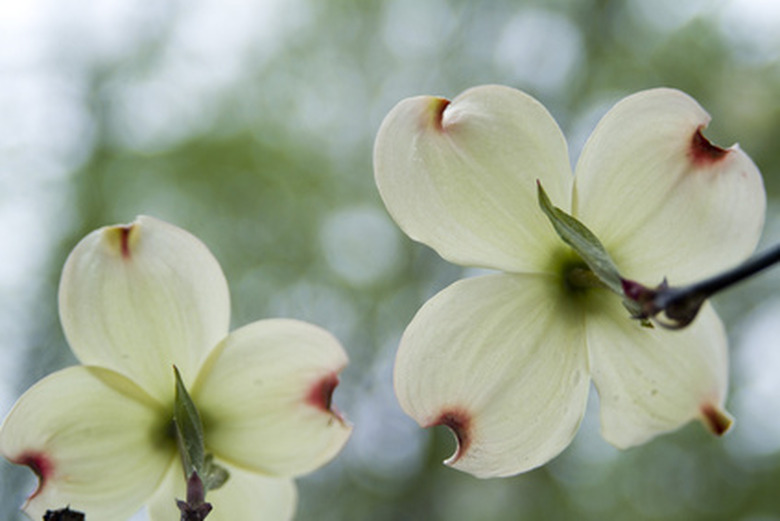What Are The Treatments For Borers In Dogwood Trees?
Several borer insects attack dogwood trees and, according to the University of Rhode Island Landscape Horticulture Program, they are the most threatening pest to established dogwoods. Control measures rely largely on perfecting the cultural conditions for the tree so that it can outgrow any damage done by the borers. Biological and chemical intervention can also be used, but rarely eradicate the problem entirely.
Borers like dogwood trees, in part, due to their thin, easily injured bark, which borers penetrate and use as breeding space. Signs of their presence include small holes in the trunk, shrunken or slightly distorted leaves and die-back of twigs and branches in the canopy of the tree, usually from the top of the crown moving downward.
Watering
Keep the tree well watered so that it never experiences drought conditions, which will quickly weaken dogwoods. Alternate deep and shallow watering to keep the soil moist around the tree's shallow roots.
- Several borer insects attack dogwood trees and, according to the University of Rhode Island Landscape Horticulture Program, they are the most threatening pest to established dogwoods.
- Keep the tree well watered so that it never experiences drought conditions, which will quickly weaken dogwoods.
Removal of Diseased Wood
Prune away any wilting foliage, holey or diseased wood immediately when you see it in the tree. Collect all the cuttings, burn or dispose of them, and refrain from introducing the cuttings into the compost pile.
Trunk Protection
Protect the trunk bark from injury, gouges, knocks or wounds of any kind. Keep all lawn equipment well away from the tree, along with keeping kids from climbing or kicking your dogwood. Do not spray the trunk with a hose when watering, or peel the bark back if cracked, as both will only create a greater number of entry points for the borer.
Chemical Sprays
Trees infected with borers can be sprayed with a residual insecticide product in the summer to reduce the amount of adult borer insects active on the tree. Though it will not kill larvae in the bark or wood, it can reduce the adult population, giving the tree a bit of a break to try and outgrow their damage. The entire tree will need to be coated repeatedly and because of the chemicals involved, professional arborists or trained fumigators are commonly engaged for the task.
- Prune away any wilting foliage, holey or diseased wood immediately when you see it in the tree.
- Do not spray the trunk with a hose when watering, or peel the bark back if cracked, as both will only create a greater number of entry points for the borer.
Fertilizer
Fighting dogwood borer requires the tree to develop new woody and leaf tissue at a faster rate than the activity of the borers can destroy it. In addition to water, fertilizer plays a key role in this. Use a complete, slow-release or organic fertilizer product designed for dogwoods or other acid-loving plants such as azaleas and rhododendrons. Apply regular doses according to the product label directions and water in well. Refrain from using fast-release chemical fertilizers as these can burn the shallow roots placing the tree under even more stress.
Biological Controls
Dogwoods can also be coated with entomopathogenic nematodes which are parasitic insects that will kill the borer larvae. The nematodes are sprayed onto the trunk and branches in the spring, summer and/or early fall and left to do their work. According to the University of Delaware Extension, entomopathogenic nematodes are at least as effective on borers as insecticides and less damaging to the environment,
- Fighting dogwood borer requires the tree to develop new woody and leaf tissue at a faster rate than the activity of the borers can destroy it.
- The nematodes are sprayed onto the trunk and branches in the spring, summer and/or early fall and left to do their work.
